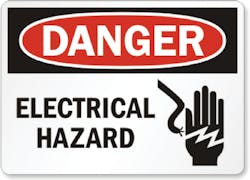We see safety signage in various shapes and forms out in the operation, but what do they actually mean?
There are many different approaches to accident prevention that airline employees deal with on a daily basis in any part of an airport environment. Training, awareness, and communication are major components in preventing accidents; one major form of visual awareness is signage that we see out in the operation throughout airport environments.
Safety signage assists ramp agents with understanding possible hazards in the operation and any actions that may need to be taken to prevent an accident. Color coding of specific signage will help us make safe decisions on how we act based on the color that is related to that specific sign. The following are some basics of safety signage which includes physical hazard identification and accident prevention.
RED = DANGER
OSHA recommends that danger signs or tags be designed and printed in red or predominantly red, with lettering or symbols in a contrasting color.
If an immediate hazard exists, danger signage should be conspicuously displayed.
Aside from just a sign hanging around to identify a hazard, ramp agents need to be trained that danger signs indicate immediate danger and should exercise special precaution in these areas.
Red must also be included on signage that is used to identify:
- Portable containers for flammable liquids; the name of the contents also needs to be affixed to the container and clearly visible. The contents may be stenciled or painted in yellow.
- Fire protection equipment, such as fire extinguishers and fire alarms.
- Emergency shut off switches for machinery and ground service equipment.
YELLOW = CAUTION
Caution signs are used to warn against potential hazards or to caution against unsafe practices and also serve as reminders for personal protective equipment (PPE) requirements.
These signs are all yellow or predominantly in yellow with lettering or symbols in a contrasting color. Caution signs and markings warn of physical hazards (striking against, slipping, falling, caught in between) and should be predominately displayed when such hazards exist.
RED-ORANGE = BIO HAZARD
The red and/or orange color on this type of signage indicates that there may be infectious substances and/or infectious waste present that may pose a risk of death, injury, or illness if exposed. This signage may also come with symbols along with lettering in contrasting color.
GREEN = SAFETY INSTRUCTIONS
Green is used to designate items in the operations that will assist in the event of an accident. The location of first aid equipment, such as emergency eye wash stations, emergency quick drench showers, and first-aid equipment are identified with this signage. These signs will have white or black lettering against a white background.
BLUE = NOTICE
General notice information signage may also be found around the airport environment. Although these generally do not have any impact on immediate workplace safety, they are used to communicate information to ramp agents regarding specific instructions or regulations.
Ramp agents should not only be familiar with the identification, procedures and proper use of signage, but with the color codes that are to be used for marking/identifying physical hazards and equipment.
Color coding is a standard way of quickly identifying hazards and provides guidance to avoid personal injury or equipment damage. In addition to color coding, the design of these signs should be uniform throughout the operation. This signage also needs to be visible at all times when corrective actions are about to take place or work is being completed and can be removed when the hazard no longer exists.
Ramp agents are required to receive training on signage recognition and also need to have an understanding about the warning information that is on accident prevention signs and tags.
The training should include:
- The purpose of color coding.
- The purpose of accident prevention signs and tags.
- The different types of accident prevention signs and tags that may be found in the operation.
- The proper use of specific signage or tags.
- The meanings of symbols and wording that are on accident prevention signs and tags.
- The special precautions that need to be taken when this signage is displayed in the operation.
Accident prevention signs that are displayed throughout the airport environment is one method of communicating hazards. But ramp agents may also encounter accident/injury prevention tags.
These tags are a temporary means of warning about a hazardous condition or an out of service piece of ground service equipment. Accident prevention tags should be used to prevent accidental injury or property damage.
For example; a “Do Not Start” tag should be placed in a conspicuous location in order to effectively block the starting mechanism. An “Out of Order” tag should be used to indicate that a piece of equipment or machinery is out of order and if used may cause an injury.
Accident prevention signs and tags should not be considered as the solution to any hazardous condition; however, they are necessary to communicate these hazards to prevent employee injury, customer injury and equipment/facility damage. Ultimately, any hazard in the operation should be eliminated through some form of a control method. Accident prevention signage and tags are required, if a hazard exists in the operation and these signs and tags must be used until the hazard can be eliminated.
For more information, please reference:
- 29 CFR 1910.144
- 29 CFR 1910.145
About the author: Kevin P. Crowley, an analyst for ground safety programs, JetBlue Airways Corp., started on the ramp in Buffalo, NY, in 1993. He's been with JetBlue for 12 years and began as an instructor at JetBlue University and taught aircraft servicing for the A320 and E190. He has additional experience in HAZMAT and dangerous goods; winter ops and deicing; and is a certified OHSA instructor.
About the Author

Kevin Crowley
About the author: Kevin P. Crowley, senior analyst for ground safety programs, CQA/ASQ, JetBlue Airways Corp., started on the ramp in Buffalo, NY, in 1993. He's been with JetBlue for 12 years and began as an instructor at JetBlue University and taught aircraft servicing for the A320 and E190. He has additional experience in HAZMAT and dangerous goods; winter ops and deicing; and is a certified OHSA instructor.
